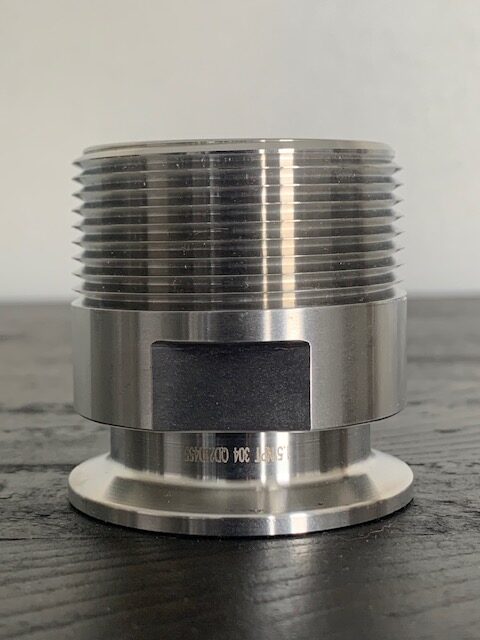How to Measure NPT Fittings
Measuring NPT (National Pipe Taper) threads accurately is crucial for ensuring proper fit and functionality in various industrial applications. Whether you’re working with pipes, fittings, or valves, understanding how to measure NPT threads correctly is essential. In this article, we will provide a step-by-step guide to help you master the art of measuring NPT threads with precision and confidence.
Many of the fitting adapters that we sell at Sanitary Fittings include NPT connections. NPT stands for National Pipe Thread and it’s a very common type of pipe threading here in the US where the threads are actually slightly tapered. This tapering assists with the sealing of NPT fittings, where in most cases the threaded end can be hand-tightened for sealing without the need for plumber’s tape or additional tools.
- Understanding NPT Threads: Before diving into the measuring process, let’s briefly understand what NPT threads are. NPT is a widely used standard for pipe threads in the United States, designed for creating leak-tight connections. These threads are tapered, meaning they get progressively larger in diameter toward the end of the pipe.
- Essential Tools: To measure NPT threads accurately, you will need a few basic tools:
- Thread Pitch Gauge: This tool helps determine the number of threads per inch (TPI) and the pitch of the thread.
- Thread Caliper: Used to measure the outside diameter (OD) and major diameter of the threaded section.
- Depth Gauge: Helps measure the depth of the thread to ensure proper engagement.
- Measuring the Thread Pitch: To determine the thread pitch, use the thread pitch gauge. Match the teeth of the gauge to the threads and check which teeth align perfectly with the threads. The corresponding number on the gauge indicates the number of threads per inch (TPI).
- Measuring the Outside Diameter (OD): To measure the outside diameter of the threaded section, use the thread caliper. Open the caliper jaws and gently slide them onto the threads until they fit snugly. Take note of the reading on the caliper scale, which represents the outside diameter of the threaded section.
- Measuring the Major Diameter: The major diameter represents the largest diameter of the tapered thread. Use the thread caliper to measure it. Position the caliper jaws on the opposite sides of the thread’s crests and record the reading displayed on the caliper scale.
- Measuring the Depth of Engagement: Proper thread engagement is crucial for a secure and leak-tight connection. Use a depth gauge to measure the depth of the threaded portion. Place the depth gauge perpendicular to the thread and slide it until it reaches the bottom. Note the measurement displayed on the depth gauge.
- Verifying Measurements: Once you have measured the thread pitch, outside diameter, major diameter, and depth of engagement, compare these measurements against the standard NPT dimensions. NPT threads have specific dimensions based on their size and TPI, so it’s essential to cross-reference your measurements with the appropriate NPT standards.
- Consult Reference Materials: To ensure accuracy and reliability, consult reference materials such as engineering handbooks, manufacturer catalogs, or online resources. These sources provide detailed information about NPT thread specifications, tolerances, and standards.


| NPT Pipe Size Measurement Guide | |
|---|---|
| Nominal Pipe Size (NPT) | Outside Diameter (Inches) |
| 1/8″ | 0.38″ |
| 1/4″ | 0.49″ |
| 3/8″ | 0.63″ |
| 1/2″ | 0.80″ |
| 3/4″ | 1.00″ |
| 1″ | 1.24″ |
| 1-1/4″ | 1.58″ |
| 1-1/2″ | 1.82″ |
| 2″ | 2.30″ |
| 2-1/2″ | 2.76″ |
| 3″ | 3.39″ |
| 4″ | 4.39″ |
Buy Stainless Steel Fittings Today!
See our full list of NPT Fittings.
Have a question or need more help? Contact our sales team for assistance.

